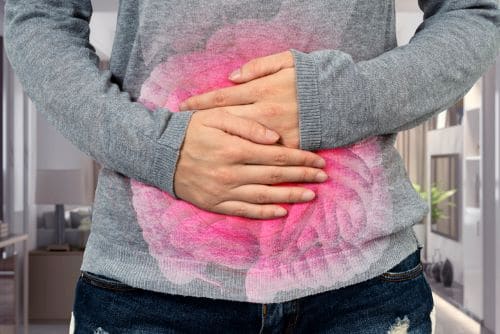Most people with celiac disease will tell you that gluten is the cause of their condition.
That’s because whenever they eat wheat products or something else with gluten, they get sick.
But what is the underlying cause? Why can’t their bodies digest gluten?
A new study suggests the hidden trigger is a group of toxic chemicals.
Researchers from the NYU Grossman School of Medicine looked at the levels of industrial chemicals in the bodies of people with and without celiac disease. They found that people with high concentrations of toxic chemicals are far more likely to suffer from celiac.[1]
Female subjects with high levels of the pesticide chemicals dichlorodiphenyldichlorethylenes (DDEs) in their systems were up to eight times more likely to have the condition.
Women with high levels of perflouoroalkyls (PFAs) were five to nine times more likely to have celiac. PFAs are chemicals used for non-stick surfaces such as Teflon.
Men with high levels of polybrominated diphenyl ethers (PBDEs) had double the chances of having celiac. PDBEs are used to make fire-resistant products.
Dr. Jeremiah Levine was the senior study investigator. He said the results establish “the first measureable tie-in between environmental exposure to toxic chemicals and celiac disease.”[2]
3 Toxic Chemicals Linked to Celiac
If you suffer from celiac disease or gluten intolerance, you may be able to improve your condition by reducing the toxins in your body. Of course, to do this, you need to know the sources of celiac-linked chemicals.
Here’s what you need to know about three toxins associated with celiac:
- PFAs. They are a group of some 4,700 chemicals. They are used in pizza boxes, microwave popcorn bags, carpets, upholstery, fast-food wrappers, dental floss, electrical insulation, plastics, and many other products.
Besides celiac disease, PFAs are linked to cancer along with immune, thyroid, kidney, and reproductive problems. PFAs are called “forever chemicals” because they break down slowly. They have a half-life of 92 years in the environment and two to eight years in the human body.
Here’s how to minimize your PFA exposure:
- Don’t use nonstick pans. PFAs are often in Teflon and other nonstick coatings. Use cast iron, stainless steel, glass, ceramic, or stoneware instead.
- Buy the right dental floss. Some brands contain Teflon-like compounds. Buy wax-coated or non-coated floss.
- Avoid stain-resistant products. Don’t buy carpets, clothing, or furniture marketed as stain resistant. Chemicals used for stain resistance contain PFAs.
- Be careful with personal care products. Check the labels of moisturizers, deodorants, cosmetics, hair gels, etc. to see if they are made with Teflon or include the words “fluoro,” “polyfluoro,” or “perfluoro.” If so, they have PFAs.
- PBDEs. These flame-retardant chemicals are linked to brain and developmental problems. They are in mattresses, couches, and foam products sold before 2005. They may still be found in some TVs and computer monitors. To avoid them:
- Get a HEPA filter. PDBEs have been widely detected in house dust. That’s because they can migrate out of furniture, TVs, and foam padding. HEPA (high-efficiency particulate air) filter units are usually small and portable. Place one in your bedroom and any other rooms where you spend a lot of time.[3]
- Replace or repair chairs, sofas, car seats, etc. that have exposed foam.[4]
- DDEs are used in pesticides. To avoid them:
- Buy organic. Not only do organic foods lack toxic chemicals, they are more nutritious. They have more antioxidants and a higher flavanol content. Flavanols lower inflammation and fight oxidative stress.[5]
- Thoroughly wash non-organic food. Here’s how to get as much pesticides as possible off produce: Fill a large bowl with four parts water to one part plain white vinegar. Soak the fruit and/or vegetables for about 20 minutes. Rinse thoroughly in water. This will remove much of the chemical residue. It won’t leave a vinegar flavor.
- Have a “no shoes” policy in your house. When people walk across lawns, parks, or other landscaped areas, their shoes can pick up chemical pesticides. Leave your shoes at the door and ask guests to do the same.[6]
Before the rise of industrial chemicals, celiac was rare in the U.S. But since 1950, the incidence of the disease has increased by more than 500%. If you have trouble with gluten, it’s important that you reduce the toxins wrecking your digestion. [7]
Editor’s Note: If you’re concerned about exposure to the toxic chemicals that are all around us, you need the Toxin Flush Protocol. It’s a detailed plan to help remove toxins from your system. It was published in Independent Healing, your best source for evidence-based health advice. Go HERE to subscribe.
Related Articles
The Hidden Danger of Sunscreen Chemicals
Toxic Chemicals in Your Mac and Cheese
Many “Gluten-Free” Foods Actually Aren’t
Like this Article? Forward this article here or Share on Facebook.
[1]https://www.sciencedirect.com/science/article/abs/pii/S0013935120303327
[2]https://medicalxpress.com/news/2020-05-celiac-disease-linked-common-chemical.html
[3]https://toxicfreefuture.org/key-issues/chemicals-of-concern/pbdes/
[4]https://www.ewg.org/enviroblog/2007/09/7-ways-reduce-your-exposure-pbde-flame-retardants
[5]http://www.ncbi.nlm.nih.gov/pubmed/24968103
[6]https://learn.eartheasy.com/articles/6-ways-to-reduce-your-exposure-to-pesticides/
[7] https://www.the-scientist.com/features/the-celiac-surge-31438

